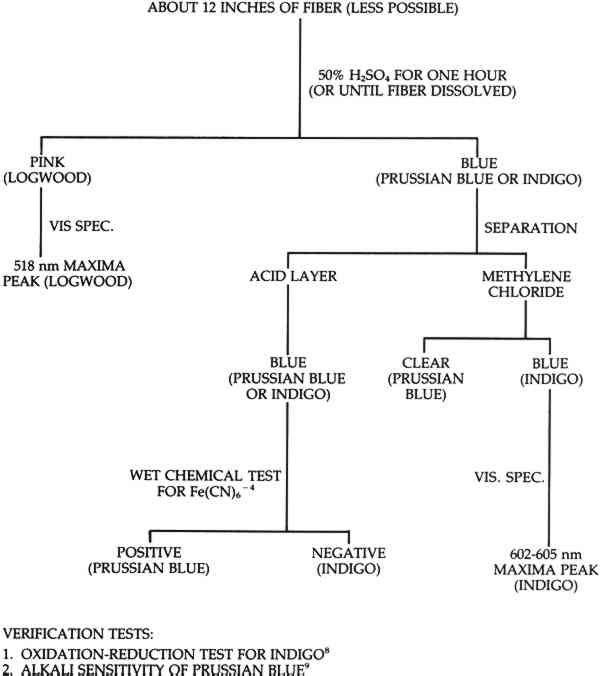BLUE DYE IDENTIFICATION ON CELLULOSIC FIBERS: INDIGO, LOGWOOD, AND PRUSSIAN BLUEAnn Cordy, & Kwan-nan Yeh
4 CONCLUSIONSTHIS STUDY USED MODERN FLAX THREAD dyed blue with either indigo, Prussian blue or logwood (iron mordant) using nineteenth century dye recipes. Responses of severely light- and heat-treated dyed modern thread simulated aging. Severely aged thread responses to identification techniques produced results similar to those for the nonaged samples and appear reliable for this set of aging conditions. The acid digestion technique would be good for cellulosics due to their acid sensitivity. Indigo, logwood, and Prussian blue dyes were not destroyed by this procedure. Some indigo was made water soluble with the addition of sulfonates. Logwood converted to pink in the acid when the mordant was cleaved off. UV-VIS spectroscopy produced clear maxima peaks in the visible range for indigo and logwood. Non-aged logwood or logwood samples that are still blue can be identified in acid solution (VIS peak of 518 nm) but on aging this peak disappears entirely. Therefore, if the fiber is still blue then logwood should be identifiable with VIS IR spectroscopy analysis of the non-aged indigo methylene chloride layer identified sulphonated groups, but with aging these identifying peaks were lost. This technique requires more sensitive sampling (e.g., microcell) to concentrate the small dye sample size. A method is needed to examine the acid layer in which non-aged Wet chemical analysis for ferrocyanide ions identified the presence of Prussian blue both for aged and non-aged samples. If metallic ions are to be identified by wet chemical analysis, then efforts should be made to use dye recipes of the period under study. Ingredients other than dyes vary with the time period and can give false identification for certain metal ion tests. It would be best to test for the dye molecule itself or, as with Prussian blue, select a more dye-specific ion to test for (e.g., ferrocyanide ion, not ferrous or ferric ions). Based on the results of this study and the review of literature, a suggested flow chart has been developed for identifying blue dyes on cellulosic fibers of 1850 to 1870 (see Figure 2). It is designed to be inexpensive, use a relatively small amount of sample, and test with equipment commonly available in most chemical laboratories; it is aimed at minimal toxicity exposure from solvents. It should be kept in mind that this chart is designed for cellulosic fibers and also that it does not mention certain other blue dyes of earlier periods (e.g., woad) or later synthetic blues.
ACKNOWLEDGEMENTSA SPECIAL THANKS IS EXTENDED to Dr. Steven Spivak and Mr. Earl J. Coates whose initial questioning, encouragement, and guidance led to the development of this research. The Division of Textiles, Museum of American History, Smithsonian Institution kindly allowed access to their excellent collection of nineteenth-century dye manuals for this research. |
